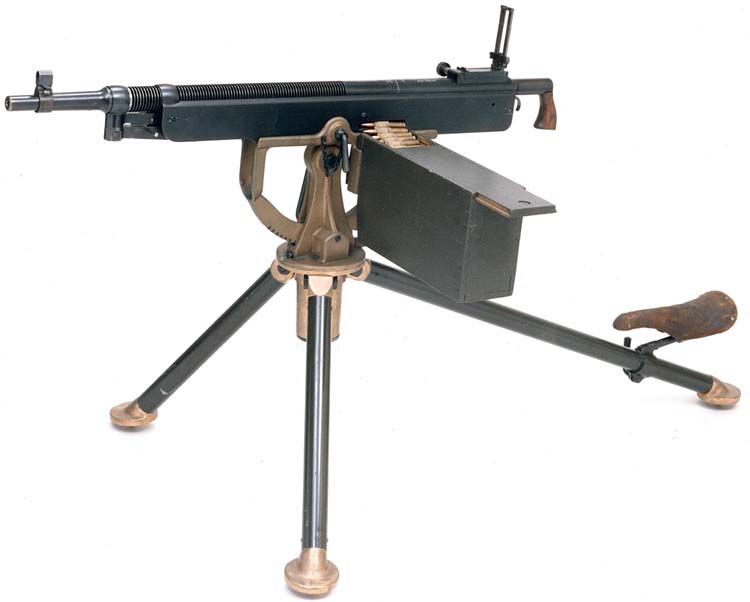
Captain Herbert W. McBride of the 21st Battalion, Canadian Expeditionary Force, wrote in his excellent book A Rifleman Went to War the following concerning the use of the Colt Automatic Gun Model 1895. “We Canadians of the Second Division were originally equipped with Colt guns… I imagine I can hear some sniffles and horse-laughs. You think that the Colt is a poor weapon, eh? Well, just let me tell you something for your information and instruction… Never have I seen any machine gun that is as safe for shooting over the heads of advancing infantry as the Colt. In other words, it has less dispersion, vertically, than any gun I have seen… That old Colt sure would hold elevations. I have often shot and see fired by other bursts of as many as ten shots at the thousand-yard target, where not a single bullet struck outside the limits of the bull’s eye… Often we used our Colts for firing single shots – sniping – and that is practically impossible with any of the other and faster kinds.”
“And, by the way,” continues McBride, “lest we forget, there is another good argument for the Colt gun, and that is that it is air cooled. Say what you want to, the business of getting water where there ain’t any and keeping that old condenser and its holes and everything right with you and ready to hook up, when you are crawling through all the litter of a battlefield, is not so easy. And how that water does boil away! In spite of the most careful use of the condenser, it evaporates at a rapid rate and then the problem is how to replenish it. Even though the action may be literally on the bank of a river it may be an impossible task to go the few feet and back; and, often, on the soggy, rain-drenched fields of Flanders, where everything was simply soaked, not enough real water could be procured to fill the jacket. More than a few times, the members of the gun crew have been called upon to ‘make water,’ and there is a sort of grim humor in the fact that on such occasions few, if any, could produce the goods: no, not a drop.”
Such was the praise for the Colt Automatic Gun Model 1895 as written by Captain McBride. Truly, he was an original “Emma Gee” as they called all machine gunners in the British service during World War I.

History
The Colt Automatic Gun Model 1895 was the world’s first practical gas-actuated machine gun invented and designed by the firearms genius John Moses Browning. Being an avid shooter and hunter as well as a great inventor, Browning, in the fall of 1889, went on a hunt in the marshes near Great Salt Lake. Lore has it that while shooting in the bulrushes he was intrigued by the reaction of the marsh grass to the muzzle blast of his gun. Recognizing this blast as a viable energy source, he set about to harness this energy as an alternate yet efficient means of operating a firearm. (Hiram Maxim had invented the short-recoil system four years earlier.)
Initially testing his concept on a rifle and then moving forward to a fully automatic gun, by March, 1890, Browning had improved his concept gun to the point where he offered a prototype to the Colt’s Patent Fire Arms Company. The gas-impingement system that he invented was created by drilling a small gas port on the underside of the barrel about seven inches from the muzzle. As the bullet travels down the barrel past the gas port, but before exiting the muzzle, a small portion of the expanding powder gas is bled through the gas port and impinges against the head of the gas lever located under the barrel and held against the gas port. This causes the gas lever, hinged at the rear, to rotate downward and backward in a 170 degree arc underneath the gun. This lever actuates the working parts of the gun by unlocking and pushing back the bolt, withdrawing and ejecting the spent cartridge case and cocking the hammer while simultaneously the shell extractor draws a new round out of the belt and places it on the carrier. As the gas propelled lever expends its rearward energy, retracting springs return the gas lever forward and upward through its return arc to its original position.
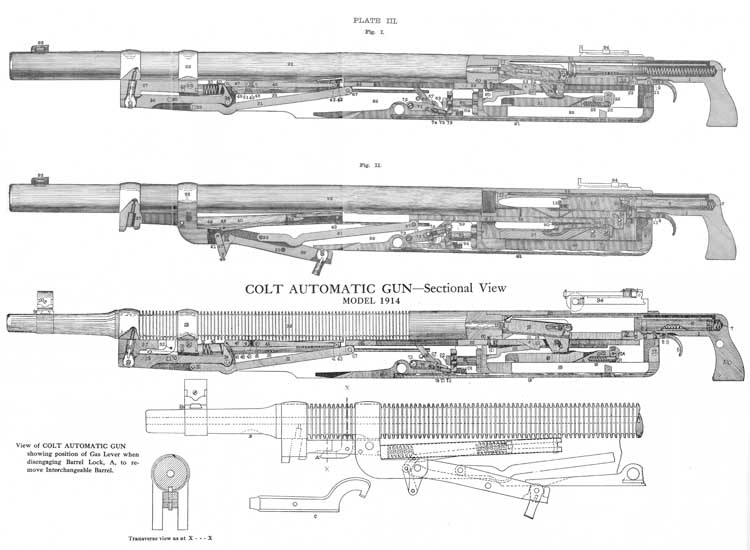
As the gas lever returns to its forward position, it causes the front end of the carrier to rise and place a new cartridge on the carrier in front of the bolt. The bolt then travels forward, places a new round in the chamber and locks in place. At the same time the feed wheel rotates and advances the belt with a fresh cartridge to be engaged by the extractor, which is also traveling forward.
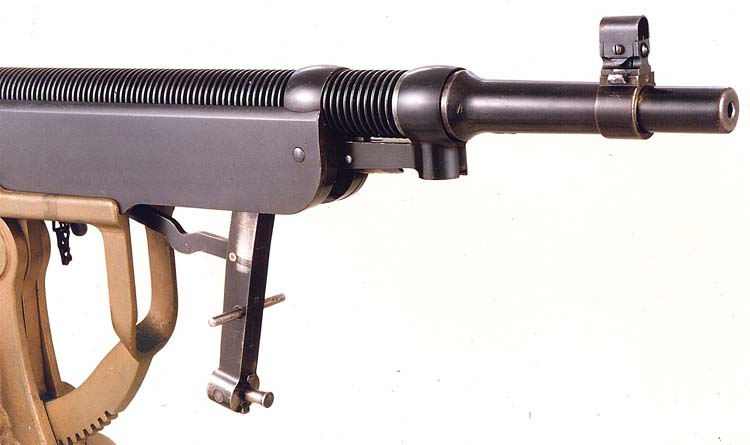
This cycle of extraction, ejection, loading, locking, cocking and firing will continue as long as the trigger remains pressed. It was this gas lever, which traveled fore and aft in an arc under the gun, that gave this weapon the nickname of “Potato Digger” because if the weapon was mounted too close to the ground, a small pit had to be dug to accommodate the swinging gas lever or else the lever would strike the ground and cause a stoppage. As “inconvenient” as this may be (tactical machine gun battlefield use had not been conceived of at this time), when mounted on its tripod, the mechanical operation of the movements resulted in a very smooth, precise and dependable operation.
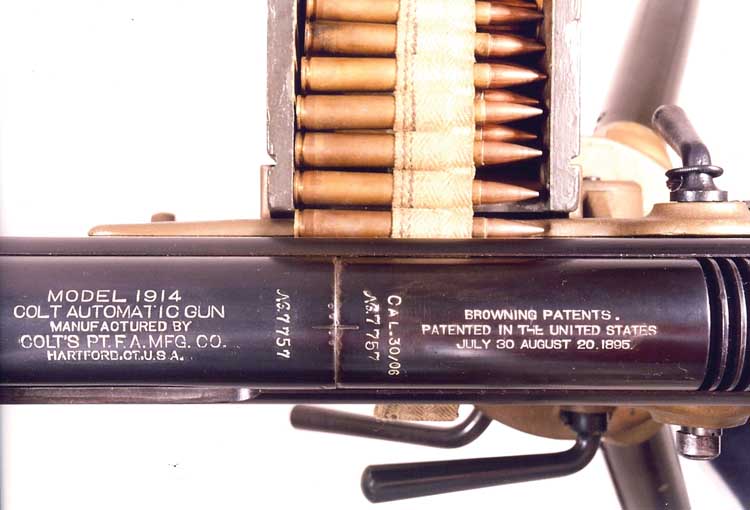
The United States Navy tested the gun as early as 1893. By 1895 it had been refined to where it would handle the 6mm Lee (Navy) and the caliber .30-40 Krag (Army) cartridges and was officially named by Colt as the Colt Automatic Gun Model 1895. The nomenclature of “Model of” was normally reserved for use by the military upon official acceptance of the type by the Army. However, Colt was confident that the gun would be ultimately accepted by the Army and named it Model 1895 (without the “of”) in anticipation of that approval. Ironically, though the gun was used in due course by the Navy and the Army, it was never officially adopted by the Army.

The Navy ordered 50 of the Colt guns, which were delivered in 1897. This was the first time the United States Government purchased an automatic machine gun. In 1898, the Navy purchased another 150 of the Colts. These guns were used as secondary armament on ships and, with wheeled Light Landing Carriages and tripod mounts, by Naval landing parties and the U.S. Marines.
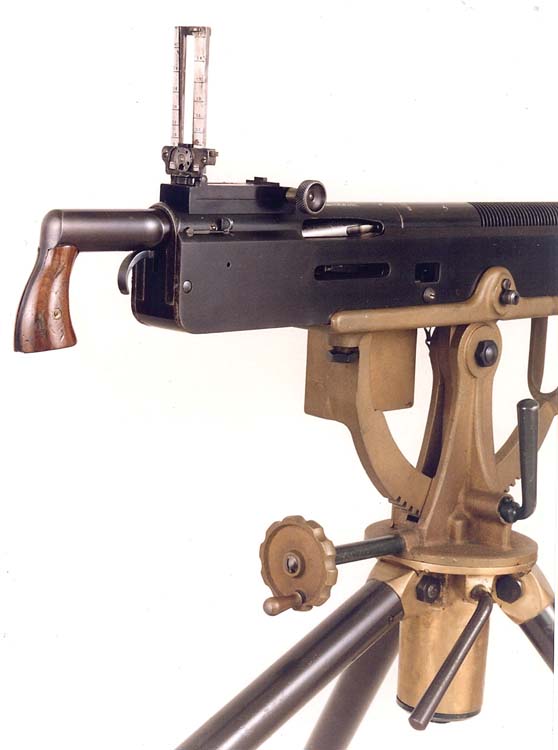
The U.S. Navy used the Colt with some degree of success during the Spanish-American War in 1898 when the Colt first saw combat. In the battle of Santiago de Cuba, Navy landing parties went into action alongside Lt. John H. “Gatling Gun” Parker and his Army Gatling gun under the command of Colonel Teddy Roosevelt. Two privately purchased 1895s chambered in 7.57mm Mauser (the same cartridge used by the Spanish in their Modelo 1893 Mauser rifles) were used by the 1st Volunteer Cavalry (Rough Riders) at Kettle Hill and San Juan Hill. However, due to the great success of the Gatling guns at the battle of San Juan Hill, the Army delayed for another decade its decision to replace the older manually operated Gatling guns with the newer automatic guns.
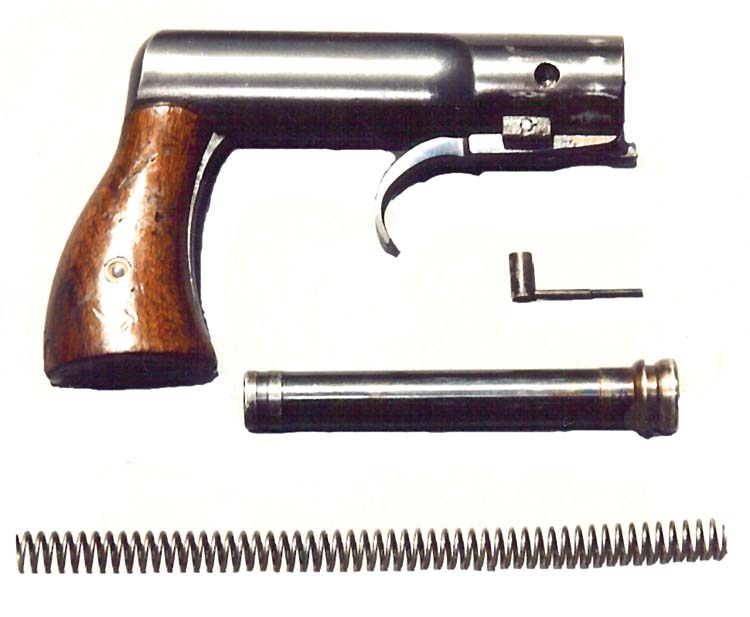
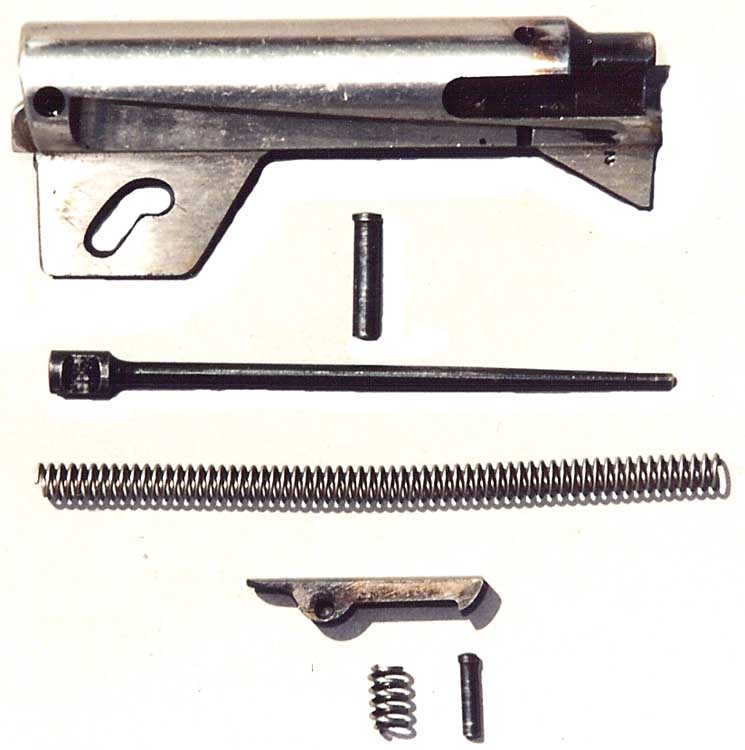
The U.S. Army did become interested in the Colt Model 1895 because of the Navy’s successful use in the Spanish-American War and purchased about 100 guns for testing and training purposes. The Army could not use the Navy’s guns because the Navy used the 6mm Lee while the Army used the .30-40 Krag. A joint Army-Navy board met in 1898 and recommended standardizing arms and ammunition for the Army, Navy and Marine Corps. As a result of this recommendation, the Navy rechambered their 6mm Lee’s to the .30-40 Krag, then to the .30-30 and finally to the Springfield .30-06. However, it is important to note that though the Army, Navy and Marine Corps used the Colt Model 1895, only the Navy officially adopted the weapon, designating them Mark I (6mm Lee), Mark I-Modification I (.30-40 Krag, .30-30 and Springfield .30-06) and Mark III (for the Model 1914 with the interchangeable barrel in .30-06). The Army just purchased them “off the shelf.” The first automatic weapons officially adopted by the U.S. Army were the Colt Maxim Model of 1904 and the Automatic Machine Rifle Model of 1909 (commonly called the Benét-Mercié).

The Colt Sees Plenty of Action
The Colt company sold the Model 1895 for commercial sales as a military weapon and ultimately sold approximately 25,000 guns world wide. Besides the United States; Russia, Belgium, Canada, Britain, Central and South American countries as well as most of the European countries purchased the Colt 1895. Attesting to the versatility of the gun, it was chambered in such diverse rounds as the 6mm Lee, .30-40 Krag, 7.65mm Mauser, 6.5mm Greek, 7mm Mexican, 7.62mm Russian, .30-06 Springfield and the .303 British, among others.
During the Boer War in South Africa (1899-1902), Canadians in service with the British Army used several Colt Model 1895s against the Boers. In 1900, in mainland China during the so-called Boxer Rebellion, the Boxer insurgents laid siege to the Foreign Legations for 55 days in Peking. Their defense was left in the hands of the small numbers of Maine Guards of the various nations. The United States Marines were equipped with two Colt 1895s and used them so effectively that they were credited with saving the Foreign Legation from annihilation. During the Mexican Revolution (1911-1916) all sides used the Colt 1895: the Mexican Federales, the Mexican Revolutionaries and U.S. troops under General “Blackjack” Pershing in skirmishes across the border with the Mexican Army. Prior to World War I, the U.S. Navy and the Marine Corps were able to put the Colt 1895 to a lot of use because of their involvement in the Philippine Pacification campaign and peace keeping efforts in Central America and the Caribbean.
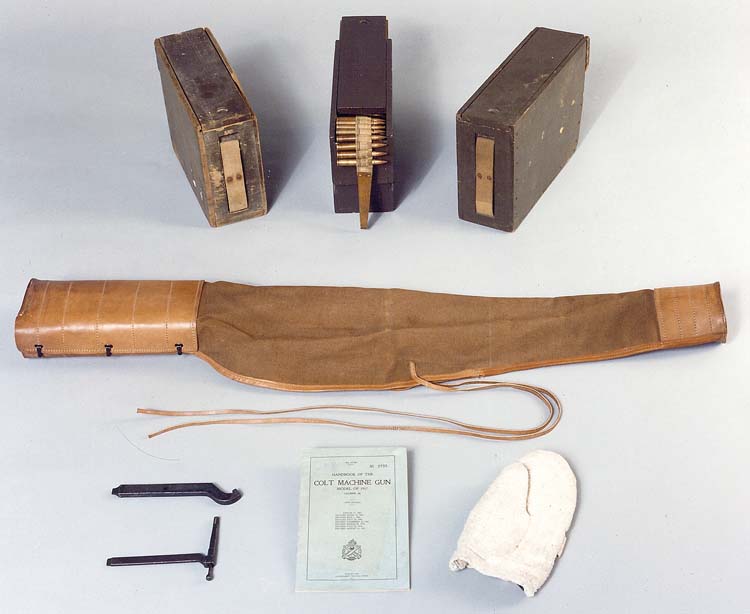
In 1914, Colt modified the Model 1895 by replacing the heavy, thick permanent barrel, which had a tendency to overheat and cause “cook-offs,” with a finned barrel that is easily changeable. The Colt Model 1895 with this modification is called the Colt Automatic Gun Model 1914.
By the time of World War I (1914-1918), the old Colt was pretty much obsolete, but the Models of 1895 and 1914 were still used by Britain, Canada, Belgium and Russia through the end of 1915 until ultimately replaced by the likes of the water-cooled Vickers and Maxim and the Lewis guns. The United States continued to use the Colt for training purposes.

The Colt Model 1895 weighs 35 pounds and its tripod, with saddle and yoke, weighs about 60 pounds depending on which tripod is used. The gun’s overall length is 41 inches with a barrel length of 28 inches. It is air cooled and fed by a 250 round cloth belt from the left side from a wood ammunition box that attaches directly to a mounting bracket on the saddle mount. The rate of fire is a very comfortable 400-450 rounds per minute and while fully automatic only in operation, with its moderate rate of fire, single shots were more than capable in the hands of an experienced gunner.

Operation
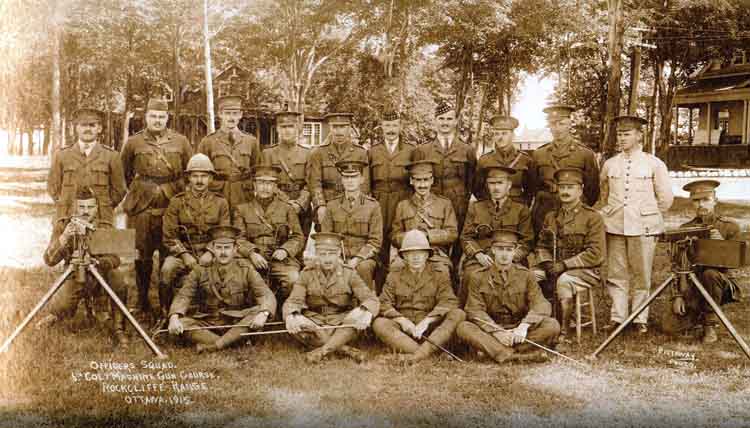
Operating the Colt Model 1895/1914 is simple and straight forward. Attach the wood ammunition box in the firing position on the left side of the saddle mount. Push the brass-tipped cloth belt from the left through the opening above the box and draw it through as far as it will go. Let go of the belt. Manually swing the gas lever downward and back to the rear until it strikes the bottom plate of the gun and release the gas lever. It will now return forward to its normal forward position. The gun is now ready to fire. Pull back on the trigger and the gun will fire until the trigger is released or until all the cartridges in the belt are expended. To hold the gun ready for firing, push the safety latch on the right side of the gun below the rear sight from “fire” to “safe.”
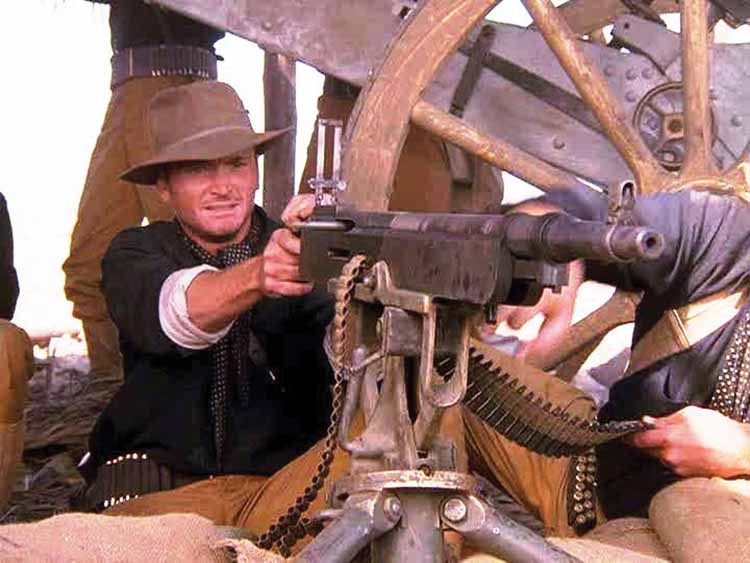
Field Stripping
To field strip the weapon, remove the belt from the gun and throw the gas lever to the rear checking the chamber to be sure it is clear and release it to return to its normal forward position. This action cocks the hammer. On the right hand side of the gun, in front of the trigger, is the handle lock, which is a pin with a small projecting lever resting in a horizontal position. Turn the lever upward and backward as far as possible. Withdraw the handle lock. This releases the handle, which can then be removed rearward. The handle contains the mainspring, hammer, sear, sear spring, trigger and trigger spring. To remove the hammer and mainspring from the handle, pull back the trigger and pull the nose of the sear down. USE EXTREME CAUTION as the compressed mainspring and hammer will literally fly out the handle unless it is controlled by your hand.
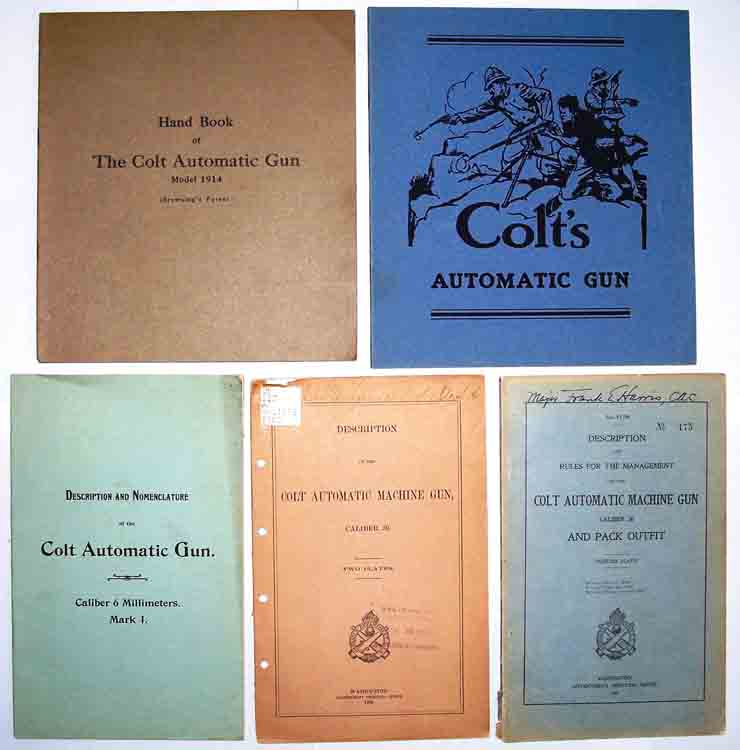
To remove the bolt, throw the gas lever rearward as far as possible, and while holding it in that position, insert the small end of the handle lock in the hole on the right hand side of the gun, pushing the handle lock in as far as it will go. This removes the bolt pin from the bolt. Withdraw the handle lock pin, but leave the bolt pin in the position in which it now is – i.e. projecting from the left side. The bolt is now free to be removed from the rear of the gun. The extractor and firing pin can be removed from the bolt by pushing out the small pins that hold them in place.
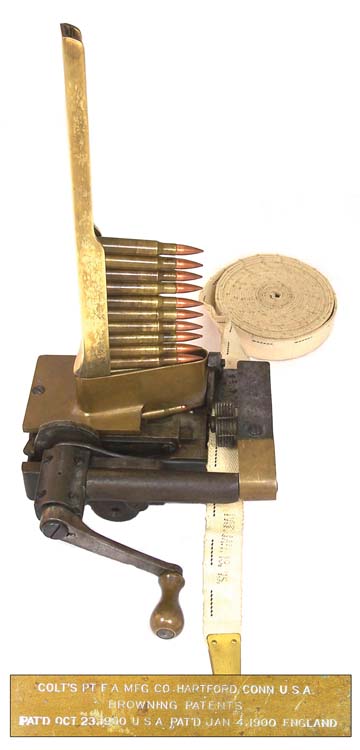
To reassemble, insert the bolt and push forward as far as it will go. Retract the gas lever to the rear and hold in place. Push in the bolt pin from the left hand side as far as it will go. Then release the gas lever to return to its forward position. Finally, replace the hand grip, locking it in position with the hand lock.
To remove the barrel on the Model 1914, retract the gas lever to the rear and hold it in place. Using the handle lock, push the bolt pin from right to left. This causes the bolt pin to lock the slide to the receiver and holds the gas lever back. Attached to the gas cylinder will be the barrel lock. Place the small end of the combination wrench under the point of the barrel lock and press down and out until it clears the barrel. Engage the combination wrench in the slot in the underside of the barrel just forward of the gas cylinder and unscrew the barrel. Pull the barrel forward and out.
Sights
The front sight on the Model 1895 is a plain leaf. The sides are grooved near the top so that the appearance of the upper part from the rear is that of a bead, which facilitates aiming. The leaf is mounted on a base which is fitted snugly into a transverse groove in the barrel, being held in position by friction only. The rear sight is a folding leaf with slide having a wind-gauge screw for traversing it laterally for windage. In its lowest position the aim is taken through the notch in the forward (upper) end of the bar; this position corresponds to a range of 300 yards. For ranges of 400 yards and upward the leaf is raised and the slide is set at the desired graduation up to 2,000 yards.
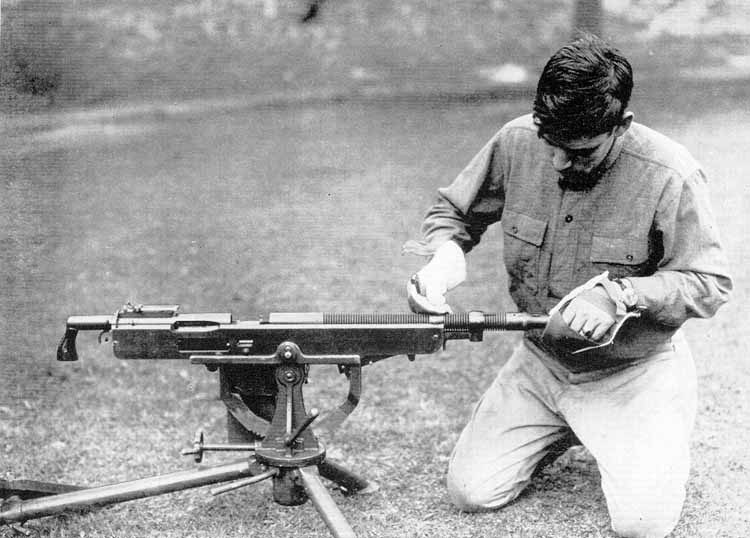
The front sight of the Model 1914 is a hooded sight and is a wedge-shaped piece of steel which is dovetailed on its bottom surface and fits into the front sight base that is also dovetailed. The front sight and front sight cover are rigidly fastened to the base by means of a clamp screw and cover screw, respectively. The carrier is a band which is pinned to the barrel and has a dovetailed slot to receive the dovetail on the bottom surface of the base and a set screw which holds it in position. The rear sight is a folding leaf type and the leaf is graduated from 100 to 2,100 yards. It sits on a base that is affixed to the receiver and is capable by means of a windage knob on the right front side of the base to traverse for windage correction. There is an aperture disk at the bottom of the slide that is circular in shape containing five sight openings – four peepholes, 0.04, 0.06, 0.08 and 0.10 inch in diameter, and one large aperture which contains an open sight.
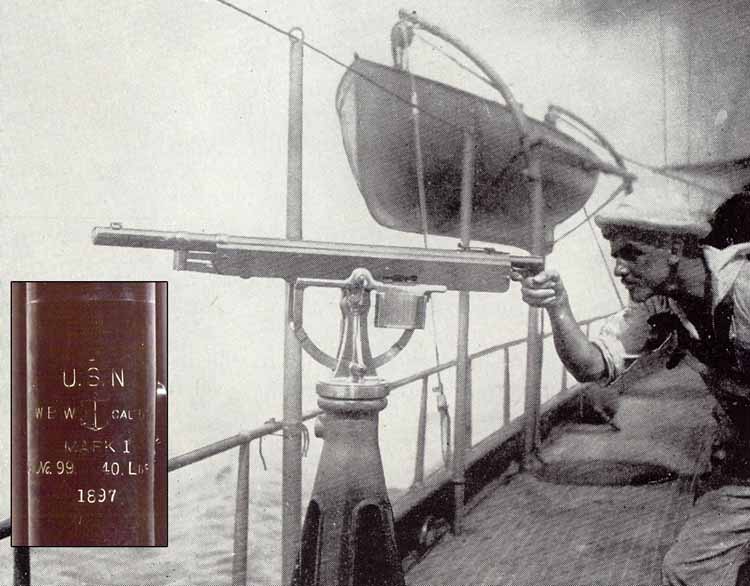
Cartridge Belt
Each gun was provided with 23 cartridge belts made of canvas by means of which the cartridges are fed into the gun. Each belt is designed to hold 250 cartridges and one is placed in each ammunition box so as to feed freely into the gun, with the end of the belt having a brass tip, which is to be inserted into the gun first. While very similar to the later Browning Model of 1917 belts, the Colt Automatic Gun belts have a slightly different pitch to the pockets. Thus Browning belts, while they can be used in the Colt Automatic Gun, will not feed reliably.
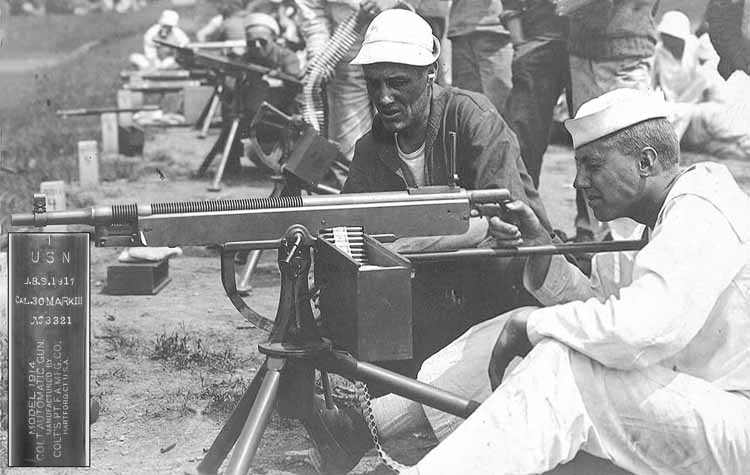
Ammunition Box
The ammunition box is designed to hold one loaded cartridge belt (250 cartridges) and is made of ash or other suitable material. It is 13 inches long, 8 inches deep and 4 1/8 inches wide in its exterior dimensions. The ends, sides and bottom are nailed together. The top is attached to the sides by means of a tongue and groove slide. Later boxes were provided with a cotton web handle attached to the end of the box. One end of the box is sloped to facilitate the egress of the ammunition belt. About one-half inch back from the vertical edge of the sloping end are cut two narrow grooves which fit over correspondingly spaced flanged ribs on the saddle mount, supporting the box and belt in position for firing on the left side of the mount. The interior of the box is given a coat of linseed oil and its exterior is painted.
The Mount
The mount consists of two principle parts: the saddle with toothed arc and the yoke. The saddle, in which the gun rests, pivots on the yoke by the axis bolt, in order to move in a vertical plane. The gun is held in place on the saddle by the gun pin, which is inserted with its handle vertical. In any other position of the handle, the gun pin is held secure by the gun-pin locking screw. Changes in elevation are made by means of a worm gear, which engages the teeth of the arc, and is operated by the hand wheel. A clamp on the right side of the saddle ensures locking at the desired elevation. The lower part of the yoke is in the form a spindle and fits in the socket of the tripod. The gun will traverse through a compete 360 degrees. A clamp on the right side of the tripod head locks the traversing motion. The muzzle may be depressed 39 degrees and elevated 31 degrees, giving a total vertical range of 70 degrees.
Tripods
There are four types of tripods, all similar except for height. The first type has very short legs and sits close to the ground with the gun’s barrel about 18 inches above the ground. This type also has a wood board attached to the rear leg that swings perpendicular to that leg. The board acts as an elbow and arm rest as the gunner lies and fires in the prone position. The second type of tripod is similar to the first except that the legs are a bit longer, it doesn’t have the elbow rest board and the gun barrel is approximately 22 inches above the ground. The third type of tripod has even longer legs and has a seat attached to the rear leg for the gunner to sit on. The barrel is approximately 28 inches above the ground. The fourth and last type of tripod has the longest legs, again with a seat for the gunner, and the gun barrel is approximately 36 inches above the ground.
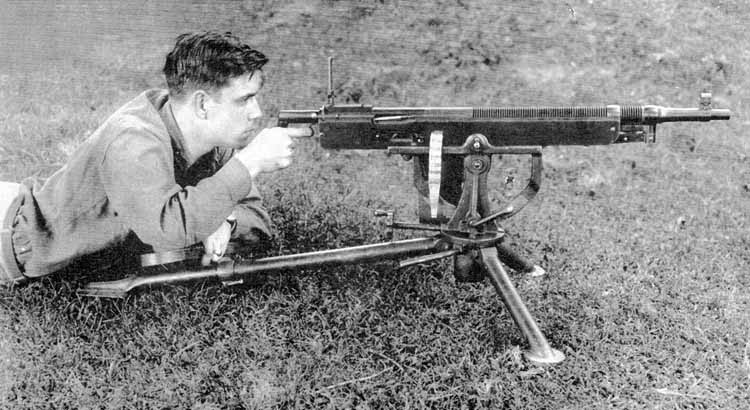
Unlike later Browning tripods, there is no leather strap that affixes to the rear leg to band the three legs together during transport nor are there any clamping mechanisms to secure the legs when deployed. The legs freely swing into set up or transportation position.
Conclusion
All in all, the Colt Automatic Gun Models 1895 and 1914 are important in respect to the early development and use of machine guns. As the first practical gas-operated machine gun as invented by John Browning, they proved themselves in the combat arena and are today desirable collector items and enhance any classic machine gun collection.
The Colt Automatic Gun Makes its Firing Debut in the Movie Rough Riders
The Colt Automatic Gun is rarely seen in the movies. It did appear briefly in The Wind and the Lion (1975) starring Sean Connery and directed by John Milius. In that movie, U.S. Navy sailors are shown in the landing party in Tangiers bringing a Colt 1895 with them but never fire it. According to director Milius, it was a non-firing mock-up as the production company was unable to find a firing one. However, in the 2006 Turner Network Television made for TV mini-series movie Rough Riders starring Tom Berenger as Teddy Roosevelt, the old Colt was shown a number of times throughout the film in good operational use – though there is a bit of an anachronism in that Model 1914s were used instead of Model 1895s because the production company couldn’t locate operational 1895s for use. This movie, also directed by John Milius, one of Hollywood’s true but rare firearms aficionados, gave the old Colts (two of them) some good firing air time and also featured a brass Maxim in operation as used by the Spanish. An excellent movie, it is available on DVD. Light Landing Carriage
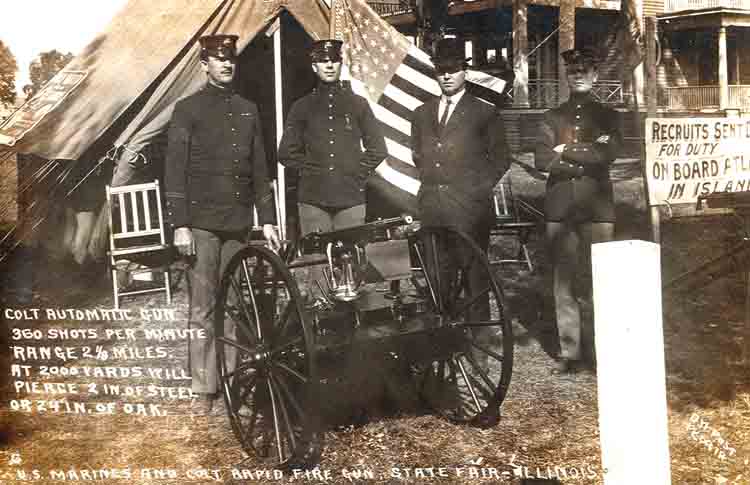
The Light Landing Carriage was used by the U.S. Navy and U.S. Marines as a means of transporting the gun and eight boxes of ammunition, all in a ready state, as they came ashore and provided excellent mobility primarily by man but also by mule or machine. The two wheels are of wood and are held on the axel by the axel washers and the axel linchpins. The axel washers each have eyes into which dragropes may be fastened if desired. The tow axel arms are connected together by the axle body to the middle of which is secured the socket. The trail, which is made of steel tubing, is secured to the socket by the trail pin. The rear end of the trail is provided with a wooden crossbar or handle for use in moving the carriage about, and also a ring or lunette for the attachment of a dragrope in case of necessity. The carriage has accommodation for two ammunition chests, which are removable and are held in place by lock pins for a capacity of 8 ammunition boxes. The front ammunition chest holds two ammunition boxes horizontally. The rear ammunition chest holds six ammunition boxes upright as well as a space for a spare parts wallet and a cleaning rod handle. Affixed to the drop down lid are two sections of the cleaning rod. The ammunition boxes are of the slightly smaller type than are typically encountered. Depending on the caliber of the gun, the landing carriage ammunition boxes were to hold two belts each of 120 rounds, or 240 rounds per box. With different ammunition, the ammunition box was to contain one 250-round belt. Thus, depending on the cartridge, the carriage capacity was 8 ammunition boxes with either 1,920 rounds or 2,000 rounds. The carriage had a net weight of 146 pounds and a gross weight of 290 pounds. The dimensions of the carriage are 54.25 x 47.75 x 19.5 inches.
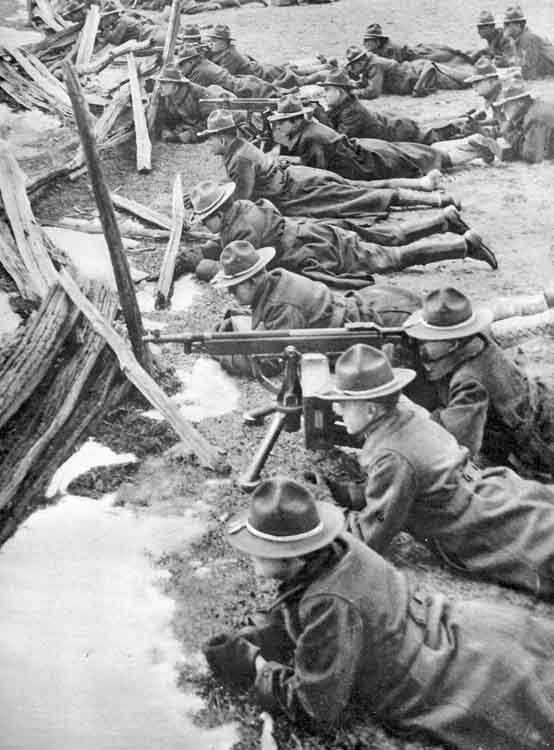
Spare parts and accessories regularly supplied with each gun included: 1 main spring, 1 hammer, 1 cartridge extractor and spring, 2 firing pins, 2 firing pin springs, 2 firing pin lock pins, 2 shell extractors, 2 shell extractor springs, 2 shell extractor pins, 2 handle locks, 2 bolt pins, 2 trigger springs, 4 cotter pins for piston pin, 1 piston pin, 1 oil can, 1 combination spanner and screw driver, 1 jointed cleaning rod, 1 combination operating handle and screw driver and 3 drifts.
Operation: Full automatic, gas impingement system
Cooled: Air
Weight: Gun: 35 lbs. Tripod: 56 lbs.
Overall length: 41 inches
Barrel length: 28 inches
Rifling: 4 grooves
Twist: One turn in ten inches
Cyclic rate: 400-450 rounds per minute
Feed: 250-round cloth belt
Sights- Front: Protected blade
Sights- Rear: Ladder type graduated to 2,600 yards
Feed box, empty: 2.50 pounds
Loaded belt, 250 rds 15.82 pounds
Feed box, full: 18.32 pounds
Belt loading machine: 13.8 pounds
Production: Approximately 100,000 of all models.
Calibers: 6mm Lee, 6mm Remington, 6.5mm Mondragon, 6.5mm Italy, 6.5mm Romania, 6.5mm Holland, 7mm Mauser, 7.5mm Swiss, 7.65mm Belgian Mauser, 8mm German, 8mm Mannlicher, 8mm, Austrian, 7.9mm China, .303 English, .30-40 Krag U.S., .30-03 U.S., .30-06 U.S.
Manufacturer: Colt, Marlin-Rockwell
| This article first appeared in Small Arms Review V14N5 (February 2011) |











